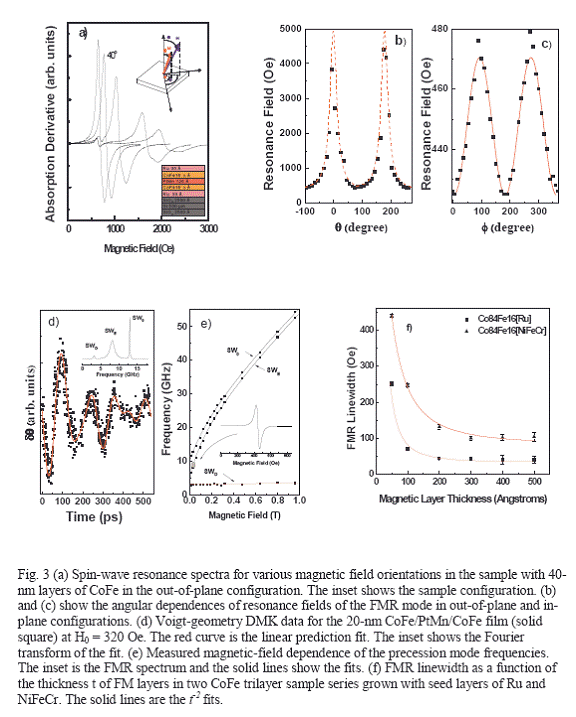

45001-G5
Ultrafast Time-Resolved Optical Studies of Colossal Magneto-Resistance Materials
Femtosecond time-resolved optical and magneto-optical Kerr studies of spin-lattice relaxation dynamics in CMR compounds: We performed transient reflectivity and magneto-optical Kerr (MOKE) measurements from the Colossal Magnetoresistance compounds: La0.67Ca0.33MnO3 (LCMO), La0.67Sr0.33MnO3 (LSMO), and Sr2FeMoO6 (SFMO) as a function of temperature and magnetic field. In LCMO and LSMO, an unusually slow ~ 1 µs carrier relaxation component is revealed in the transient reflectivity traces. The component disappears as the transition temperature is approached from below. This slow decay process is attributed to spin-lattice relaxation of carriers in localized states and shows a close relationship with the spectral weight near the Fermi surface. The attribution is further supported by our pump-probe magneto-optical Kerr measurements. In addition to the clear observation of magnetic precessions, a long-lived exponentially decaying background reflects the spin-related relaxation of photoexcited electrons. In contrast to manganites, the temperature dependence of transient reflectivity is negligible, although there is a significant change in transient Kerr rotation in SFMO. Our results show that the dynamics of charge, spin, and lattice are strongly correlated with each other in the manganites, but the spin degree of freedom is thermally insulated from the electron and lattice systems in SFMO.
Charge-orbital correlations and long-range lattice deformations arising from Jahn-Teller defects in CMR manganites: We further used the 1.55-eV photon energy (~ 800 nm) in time-resolved optical spectroscopy to estimate directly the behavior of the CE charge-orbital ordered (CO) state in the CMR manganite, LCMO. The 1.55-eV photon energy lies in a broad absorption band in LCMO centered at 1.4 eV, which has been attributed to an intra-atomic transition between Jahn-Teller (JT) split eg levels of the Mn3+ ions. The time-resolved spectra at 1.55-eV provide a powerful means to study the electronic inhomogenity in LCMO. We have performed transient reflectivity measurement in the temperature range from 4 K to 480 K. The temperature dependence of DR at t = 0 has shown a very similar behavior as the changes of the resistivity and the scattering intensity near TC which is due to the nanoscale CO clusters. The result is consistent with the percolative nature of phase separated clusters Moreover, we identified a new temperature scale T* ~ 400 K that is for the clean limit to the formation of charge-ordered clusters in LCMO.
Magnetic anisotropy and spin wave relaxation in CoFe/PtMn/CoFe trilayer
films: Last, we investigated the dynamical magnetic properties and the
spin wave relaxation in trilayer structures of CoFe/PtMn/CoFe
grown on the seed layer Ru or NiFeCr
with CoFe compositions being Co-16 at.\% Fe. The
measurements were taken in samples with the ferromagnetic layers of CoFe varying from 10 Å to 500 Å by the ferromagnetic
resonance (FMR) and the ultrafast Kerr-rotation techniques. The magnetic
anisotropic parameters were investigated by rotating the field aligned axis
with respect to the spectral field in the configurations of both in-plane and
out-of-plane in FMR and by recording the spin wave frequency as a function of
applied magnetic field in Voigt
geometry. We determined the uniaxial in-plane
anisotropic parameter of ~ 0.005 T, the effective magnetization of ~ 2.4 T, and
the exchaneg stiffness D of ~ 512 meV.
Å2. Moreover, spin wave damping was estimated by analyzing the FMR linewidth and lineshape as a
function of the angle between the external field and easy axis and as a
function of the CoFe layer thickness. We identify an
extrinsic contribution of the damping parameter dominated by two-magnon scattering in addition to the intrinsic Gilbert term
with a damping parameter, ¦Á = 0.012.
Further, we reveal that a significant linewidth
broadening could also be caused by the overlap of the surface and the uniform
spin wave excitations. The surface anisotropy contribution is found to be
critical for understanding the magnetization dynamics.


